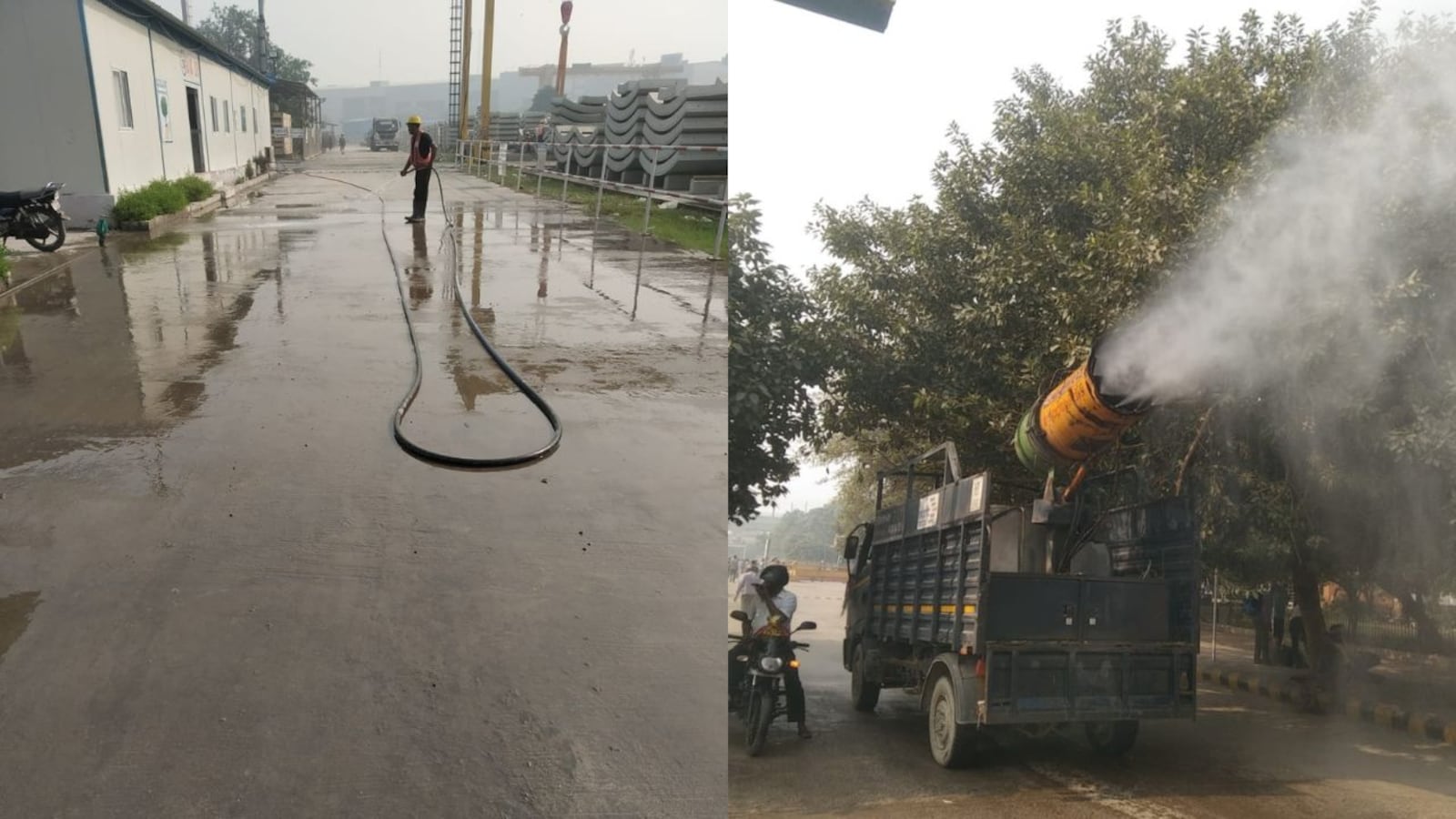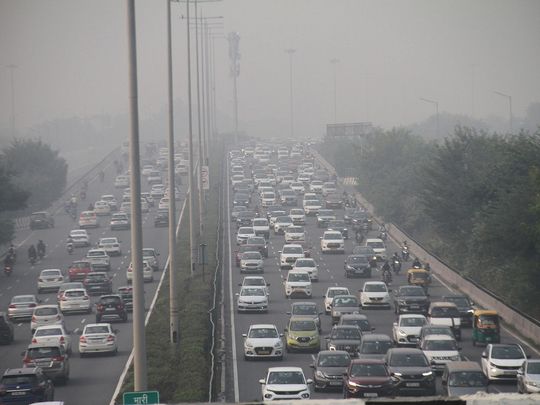Delhi Enforces Stringent Measures to Combat Pollution Crisis: Bans Truck Entry, Construction Work, and Mulls School Closures

Delhi Enforces Stringent Measures to Combat Pollution Crisis: Bans Truck Entry, Construction Work, and Mulls School Closures
In the wake of alarming levels of air pollution, Delhi has ramped up its efforts to combat the crisis by imposing stricter measures to protect the health and well-being of its residents. The Commission for Air Quality Management (CAQM) has activated Stage IV of the Graded Response Action Plan (GRAP) in the National Capital Region (NCR). These measures, aimed at curbing pollution, have taken center stage as Delhiites grapple with the dire consequences of poor air quality.
Air pollution in Delhi is not a new issue; it has been a persistent concern, particularly during the winter months when a combination of factors, including weather conditions, vehicular emissions, industrial activities, and crop residue burning in neighboring states, create a toxic cocktail of pollutants in the air. However, this year’s pollution levels have hit record highs, prompting immediate and stringent action.
One of the key measures taken by the CAQM is the temporary ban on the entry of trucks into the city. This measure excludes trucks providing essential services like the transportation of food and medical supplies. Heavy-duty vehicles, often a significant contributor to air pollution, emit pollutants such as particulate matter (PM2.5 and PM10) and nitrogen oxides (NOx). By limiting their presence on Delhi’s roads, authorities aim to reduce the volume of harmful emissions released into the atmosphere.
Simultaneously, all construction activities have been suspended in the city. Construction sites are notorious sources of dust and particulate matter, which can easily become airborne and add to the already polluted air. Halting construction work temporarily is a critical step to mitigate this source of pollution and protect the health of the city’s residents.

Additionally, state governments in the NCR have been advised to consider discontinuing physical classes for students in grades 6 to 9 and class 11. This step, while aimed at safeguarding the health of schoolchildren, is not without its challenges, particularly concerning the continuity of education and the potential impact on the academic progress of students.
The decision to implement these measures comes in the wake of the hazardous air quality levels that Delhi has been experiencing. The Air Quality Index (AQI), which measures the concentration of pollutants in the air, has frequently reached severe levels, posing serious health risks to the city’s residents. The implications of such high pollution levels are manifold and have significant consequences for public health, the environment, and the economy.
To better understand the gravity of the situation, it’s essential to delve deeper into the reasons behind Delhi’s perennial struggle with air pollution and the potential outcomes of these new measures.
Understanding Delhi’s Ongoing Battle with Air Pollution
Delhi’s struggle with air pollution is a complex and multifaceted challenge. Several contributing factors combine to create a perfect storm of poor air quality during the winter months.
1. Weather Conditions: Delhi’s geographical location makes it susceptible to adverse weather conditions during the winter, such as temperature inversions. These conditions trap pollutants close to the ground, preventing their dispersion into the atmosphere.
2. Vehicular Emissions: The city’s high population density, coupled with a significant number of vehicles on the road, results in substantial emissions of pollutants. Diesel-powered vehicles, often used for commercial purposes, are a notable source of particulate matter and NOx emissions.
3. Industrial Activities: Delhi and the surrounding NCR host a multitude of industrial units, many of which emit pollutants into the air. These emissions contribute significantly to the overall pollution levels.
4. Crop Residue Burning: During the post-harvest season, farmers in neighboring states burn crop residue as a cost-effective method of clearing fields for the next planting season. This practice releases a substantial amount of pollutants into the air, which often drifts towards Delhi.
5. Construction Dust: Ongoing construction activities in the city generate vast amounts of dust and particulate matter, further worsening the air quality.

Implications of Stricter Measures
The decision to impose Stage IV of the GRAP and restrict truck entry and construction work reflects the severity of the air quality crisis in Delhi. These measures aim to address specific sources of pollution and mitigate the adverse effects on public health. Let’s take a closer look at the potential implications of these actions:
1. Reduced Emissions: Banning the entry of non-essential trucks and suspending construction activities will lead to a reduction in the emission of pollutants. This reduction is expected to alleviate the immediate air quality concerns.
2. Health Benefits: Improved air quality can have significant health benefits. Reducing exposure to high levels of air pollution can lower the risk of respiratory diseases, cardiovascular problems, and other pollution-related health issues.
3. Environmental Impact: Stricter measures can also have positive effects on the environment, including improved water and soil quality. Reduced pollution levels can benefit ecosystems and wildlife in the region.
4. Economic Implications: While these measures are vital for public health, they can also have economic consequences. Businesses and industries, particularly those reliant on transportation and construction, may face disruptions and financial losses.
5. Education Challenges: The potential suspension of physical classes for students in certain grades presents challenges in maintaining the quality of education. Remote learning may not be accessible to all students, exacerbating educational disparities.
The Road Ahead
As Delhi grapples with this pollution crisis, it’s essential to acknowledge that these measures are not standalone solutions but part of a broader strategy to combat air pollution in the long term. To achieve sustained improvements in air quality, the following actions are vital:
1. Transition to Cleaner Energy: Promoting the use of clean energy sources, such as electric vehicles and renewable energy, can significantly reduce emissions from transportation and industry.
2. Rural Development: Addressing the issue of crop residue burning requires investments in rural development and sustainable farming practices. Providing farmers with alternatives to burning crop residue is essential.
3. Improved Public Transportation: Expanding and enhancing public transportation networks can reduce the reliance on personal vehicles, subsequently reducing emissions.
4. Green Urban Planning: Incorporating green spaces and sustainable urban planning into city development can help reduce pollution and improve overall quality of life.
5. Public Awareness: Raising awareness about the consequences of air pollution and the individual actions that can be taken to reduce it is crucial. Citizen participation is key to the success of any pollution mitigation efforts.

In conclusion, the recent stringent measures imposed in Delhi to combat the pollution crisis reflect the urgent need to address the ongoing air quality concerns in the city. While these measures may come with short-term challenges, they are a crucial step towards protecting the health and well-being of Delhi’s residents. However, it is equally important to adopt a holistic approach that addresses the root causes of air pollution to ensure a sustainable and pollution-free future for the capital and its people.




